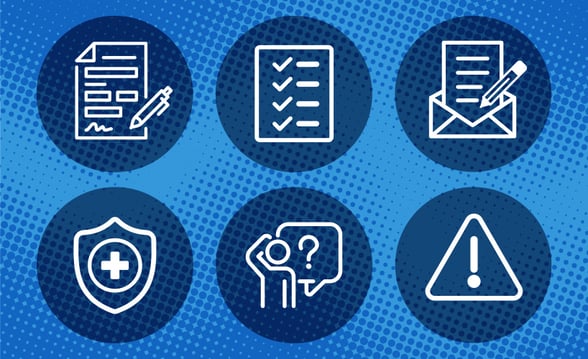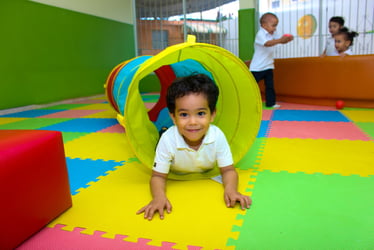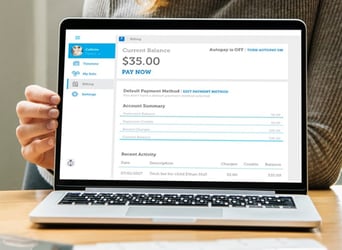
Preschool after-school programs aren’t just filling a time gap anymore; they’re becoming essential. With 59% of U.S. children under 5 in some form of non-parental care, the demand for safe and engaging aftercare for preschoolers has surged.
You already know how much structure and support young children need, especially in the late afternoons. These extended-day preschool programs give working families peace of mind while helping kids thrive socially and emotionally.
This guide provides practical insights on managing preschool programs efficiently, designing the right preschool after-school program schedule and meeting staff requirements without losing your mind.
Table of Contents
- What Are Preschool After-School Programs?
- Benefits of After-School Care for Preschoolers
- Best Practices for Structuring a Preschool After-School Program
- Engaging After-School Activities for Preschoolers
- Curriculum and Learning Support in Aftercare
- Budgeting and Managing Operations
- How Vanco Supports Preschool After-School Programs
- 100+ Free Afterschool Program Templates to Save Time & Money
- FAQs
- Conclusion
What Are Preschool After-School Programs?
If you’ve ever tried to find after-school activities for preschoolers that fit your schedule and your child’s needs, you already know the search is about both convenience and trust.
Preschool after-school programs give you a structured, reliable bridge between the end of the preschool day and when you’re done with work. However, more than that, they create a structured after-school routine for young children that supports their emotional security and healthy development.
Unlike elementary school aftercare, where kids might just get a snack and homework sheet, extended-day preschool programs are designed specifically for younger children’s developmental needs.
Think of more intentional play and less academic pressure. Unlike full-day preschool, where learning runs from morning to afternoon, these programs kick in after the core preschool hours, offering safe and engaging aftercare for preschoolers that doesn’t feel like “extra school.”
You’ll often find three main types:
- Play-based programs that let kids unwind while still learning
- Academic-lite sessions that reinforce what they picked up earlier in the day
- Preschool enrichment programs that introduce new skills through movement, art or music
These aren’t random activities; they’re crafted with purpose based on what works best in early learning aftercare settings. The National Association for the Education of Young Children (NAEYC) emphasizes that developmentally appropriate practice (DAP) programs enhance development; they don’t just fill time.
If you’re looking for preschool care solutions that offer your child more than just supervision, you’re not alone. When the right fit clicks, it feels less like a juggling act and more like a win for everyone involved.
Benefits of After-School Care for Preschoolers

It's no secret that the hours after preschool are unpredictable. One minute, your preschooler happily recounts snack time; the next, they’re melting down in the back seat.
That’s where preschool after-school programs earn their reputation. They bring calm, consistency and a sense of purpose to those tricky transition hours, and they do a lot more than “keep kids busy.”
Supporting Routine and Structure
You’ve probably noticed how preschoolers thrive on routine. When the day’s flow makes sense to them, their behavior and mood often fall right into place. That’s where extended-day preschool programs shine. They carry over the feeling of stability that your child gets during regular school hours.
A predictable preschool after-school program schedule, including snack, story time, group play and winding down, helps your child feel secure and in control. Experts emphasize how consistent transitions support behavior and ease anxiety. You see the difference at pickup: fewer meltdowns, more smiles.
Encouraging Social Interaction and Play
Now, let’s talk about the social magic that happens after hours. At that age, play isn't just fun; it’s foundational. Through enrichment activities for preschoolers, like music, art and imaginative games, kids practice social skills like taking turns, using their words and managing big emotions.
NAEYC says these playful interactions are directly tied to stronger emotional health. You want your child to build friendships, handle conflict and speak up for themselves, and early learning aftercare gives them the space to do that in a low-stress setting.
Reinforcing Skills Learned During the Day
You’re not expecting your child to write essays after school, but you want their care to have a purpose. Quality preschool enrichment programs reinforce classroom learning through hands-on experiences. Think of storytelling that connects to earlier lessons or STEM-themed sensory bins.
According to NAEYC, an aftercare curriculum for preschoolers works best when it supports what kids are already learning in more playful, exploratory ways. You’ll notice they retain more, ask better questions and engage with you more meaningfully at home.
Providing Safe, Supervised Environments for Working Parents
You have enough on your plate without wondering what happens after 3 p.m. A safe and engaging aftercare for preschoolers gives you peace of mind while giving your child structure, fun and learning. According to federal data, reliable care isn’t a luxury; it’s a critical support for working families.
Parent-friendly preschool programs combine trained staff with clean, stimulating environments. Affordable after-school care options allow many families to maintain work schedules without compromising their children’s safety or growth.
If you’ve ever felt the stress of that late-afternoon juggle, you’re not alone. But with the right preschool after-school program schedule, you and your child can breathe a little easier.
Best Practices for Structuring a Preschool After-School Program
Building preschool after-school programs that work — meaning they're safe, structured and sane — starts with respecting the rhythm of a preschooler’s day. You’re not running a mini-elementary school. You’re creating a structured after-school routine for young children that balances energy levels, growing brains and the real needs of working parents.
You already know it’s more than just babysitting. You’re offering a preschool care solution that supports development, social skills and security once the regular preschool day ends. Let’s talk about what matters when designing this kind of early childhood aftercare and how to do it without burning out your staff or frustrating parents.
Age-Appropriate Scheduling and Activities
Think of your preschool after-school program schedule like a flexible skeleton: sturdy but with some give. Preschoolers need structure, but not a military regime. The NAEYC recommends balancing rest, snacks, open-ended play and intentional learning.
A nap mat and a goldfish cracker shouldn’t be the highlight of a preschooler’s afternoon. Instead, plan enrichment activities for preschoolers that align with what they’re learning earlier in the day, such as art stations, guided play, or hands-on science, technology, engineering and math (STEM) exploration.
These aren’t just cute; they reinforce daytime learning and boost engagement. Time for unstructured play matters, too. You’re not doing them favors by cramming in “bonus” academics nonstop.
Safe and Inviting Learning Spaces
You can’t run a safe and engaging aftercare for preschoolers without secure and sensory-friendly environments. That means childproofing isn’t optional; it’s policy. Plug covers, locked cabinets and sanitized surfaces should be your baseline.
Kids this age need visual order, too. Cozy nooks, labeled bins and clearly defined spaces reduce overstimulation and support a structured after-school routine for young children. When your environment is calm and organized, kids behave better. It’s not magic; it’s design.
Staffing Considerations
Let’s talk about staffing. You need people who get preschoolers. According to NAEYC, the gold standard is a 1:10 adult-to-child ratio for ages 30 months to 5 years. And for foundational skills, your staff should hold relevant certifications, CPR, first aid and preferably some training in early childhood education.
Staff requirements for preschool after-school programs should include ongoing professional development. These team members are not just keeping kids alive; they’re shaping how children learn, behave and feel after a long day.
Clear Communication with Parents
You can’t have a parent-friendly preschool program without rock-solid communication. Think sign-out procedures (like Vanco Smartcare), real-time updates and clearly defined behavior policies. Parents are trusting you with their children’s routines and safety. Please keep them in the loop.
Whether it’s a simple note home or an app-based update, strong communication turns your preschool enrichment program into a reliable support system. In today’s world, that counts more than ever.
You’re not just managing snack time; you’re managing preschool programs efficiently. That means every detail matters.
Engaging After-School Activities for Preschoolers
After a long day of circle time, snack breaks and singing the alphabet for the fifth time, your preschoolers still have energy. That’s the magic (and challenge) of preschool after-school programs — you’ve got a window of time where they’re no longer in their structured morning routine, but they’re also nowhere near ready to go home and crash.
That’s where enrichment activities for preschoolers come in. When done well, they make the hours fly by for kids and staff alike.
Sensory and Creative Play
You already know that when you hand a child a lump of playdough or a paintbrush, you’re not just giving them a distraction; you’re encouraging fine motor skills, creative thinking and self-expression. In extended-day preschool programs, these aren’t optional extras. They're staples of a structured after-school routine for young children.
Activities like free art stations, collaborative mural painting, music circles or simply building towers with foam blocks can turn late afternoons into a surprisingly productive time. This safe and engaging aftercare for preschoolers helps you reinforce what they learned earlier, but without repeating the day’s schedule.
Outdoor Time and Movement Games
If you’re not building in outdoor time, brace yourself: those little legs are going to run somewhere, so you might as well give them a safe space to do it. Outdoor activities like tricycle tracks, obstacle courses with pool noodles and cones or even guided yoga in the grass aren’t just about burning energy.
They're part of a healthy preschool after-school program schedule. According to the NAEYC, gross motor play in after-school programs supports both emotional regulation and physical development. Translation? Less whining, more balance.
Story Time and Language Games
Language activities can easily slide into the quieter portion of your preschool care after-school schedule. You know how it goes: circle up, bring out the puppet box and suddenly, you’ve got a captive audience.
Storybooks, puppet shows and rhyming games support emerging literacy and give you a calm, centered way to wrap up the day. These are essential components of an aftercare curriculum for preschoolers, especially when you’re trying to align with daytime learning goals.
Simple STEM and Exploration Activities
No, you don’t need lab coats. A preschool program needs to make room for science on a preschool level. Nature walks, water tables and color-sorting stations introduce logic and discovery through play. You’re not just managing chaos; you’re quietly building thinkers.
This kind of preschool care solution fits beautifully into early learning aftercare models and makes your afternoons fun and intentional. Now you’ve got a manageable, parent-friendly preschool program, with kids who are excited to stay after class and parents who aren’t rushing the pick-up line.
Curriculum and Learning Support in Aftercare
Preschool after-school programs aren’t just glorified babysitting; they’re extensions of a child’s day, and you feel it every time a parent asks what their child learned after 3 p.m.
The best extended-day preschool programs don’t wing it. They align with daytime curriculum goals, reinforcing what’s taught in the morning without making it feel like extra work.
Through enrichment activities for preschoolers, you introduce themes, inquiry-based projects and a structured after-school routine for young children that sticks.
Social-emotional growth isn’t a buzzword here; it’s built into your aftercare curriculum for preschoolers.
Budgeting and Managing Operations
Estimating Costs for Staff, Supplies and Snacks
Running a preschool after-school program means juggling several costs: staff salaries, supplies, snacks and facilities. It’s easy for expenses to add up quickly, and if you’re not careful, those budget lines can get out of hand.
Did you know that rent and utilities alone can eat up to 32% of your total costs? Getting a handle on these expenses is crucial to running a safe and engaging aftercare program. Having a clear budget helps you stay organized and prioritize what's important.
Affordable Program Models
Creating affordable after-school care options doesn’t have to be a headache. With careful planning, sliding-scale fees and grants can make the program accessible to families.
It’s all about finding a balance that ensures quality care while keeping costs manageable. Flexible pricing models can make your preschool care solutions more appealing to parents.
Managing Payments and Tuition Collection

Managing payments in a preschool after-school program can be tedious, but it doesn’t have to be. Automating the process, like with Vanco’s payment solutions, can save you time and reduce errors.
By streamlining billing and payments, you can focus more on providing enriching after-school activities for preschoolers instead of worrying about administrative tasks.
For more info on automating your operations, check out how Vanco can help with tuition collection and financial operations.
How Vanco Supports Preschool After-School Programs
When running a preschool after-school program, you don’t need the extra hassle of complex billing systems or endless paperwork. With Vanco's solutions, you can streamline tuition collection and recurring billing so you can focus more on the kids and less on the admin work.
As you know, tracking payments for after-school preschool care can quickly become a mountain of paperwork. That's where Vanco comes in.
Vanco also supports parent-friendly preschool programs with easy online registration and seamless communication. Parents can sign up, pay and stay in the loop without friction, and there will be no more missed payments or confusion about schedules.
By handling behind-the-scenes tasks like efficiently managing preschool programs and automating the payment process, Vanco allows your program to shine without burning out. This will enable you to focus on what matters most: providing a safe and engaging aftercare environment for preschoolers while giving parents the peace of mind they deserve.
For more details on Vanco’s support, check out this link.
100+ Free Afterschool Program Templates to Save Time & Money
We know providers like yourself are busy. That's why we made dozens of templates to help you manage the various aspects of your organization. From billing and invoicing to marketing materials, we have it all. Download all 100+ today!
FAQs
What’s the ideal schedule for a preschool after-school program?
Your extended-day preschool program rhythm should balance a 20-minute rest, 30-minute enrichment activities for preschoolers, 20-minute outdoor play, plus circle time.
Are enrichment activities appropriate for preschoolers after school?
Absolutely: Activities like art, music and early learning aftercare play reinforce skills.
How can I ensure safety in an extended-day program?
Ensure safety in an extended-day program by maintaining proper supervision, secure check-in/out procedures and trained staff. Regular safety drills and updated emergency contacts are also essential.
How do I manage parent communication in after-school care?
Offer quick daily texts and always be clear, professional and responsive.
What’s the best way to collect payments for after-school programs?
Automated tuition billing reduces admin headaches — remember, rent and utilities can eat up much of your budget.
Conclusion
Preschool after-school programs aren’t just babysitting; they’re essential for giving a structured after-school routine for young children and a safe place to grow. When you build a preschool after-school program schedule that balances rest, enrichment activities for preschoolers and social play, kids thrive and parents notice.
You handle a lot: managing preschool programs efficiently, meeting staff requirements for preschool after-school programs, and keeping things affordable. However, when your extended-day preschool programs are engaging and well-run, you make a real difference.
Learn how Vanco Aftercare Software helps streamline payment and operations for childcare centers.












